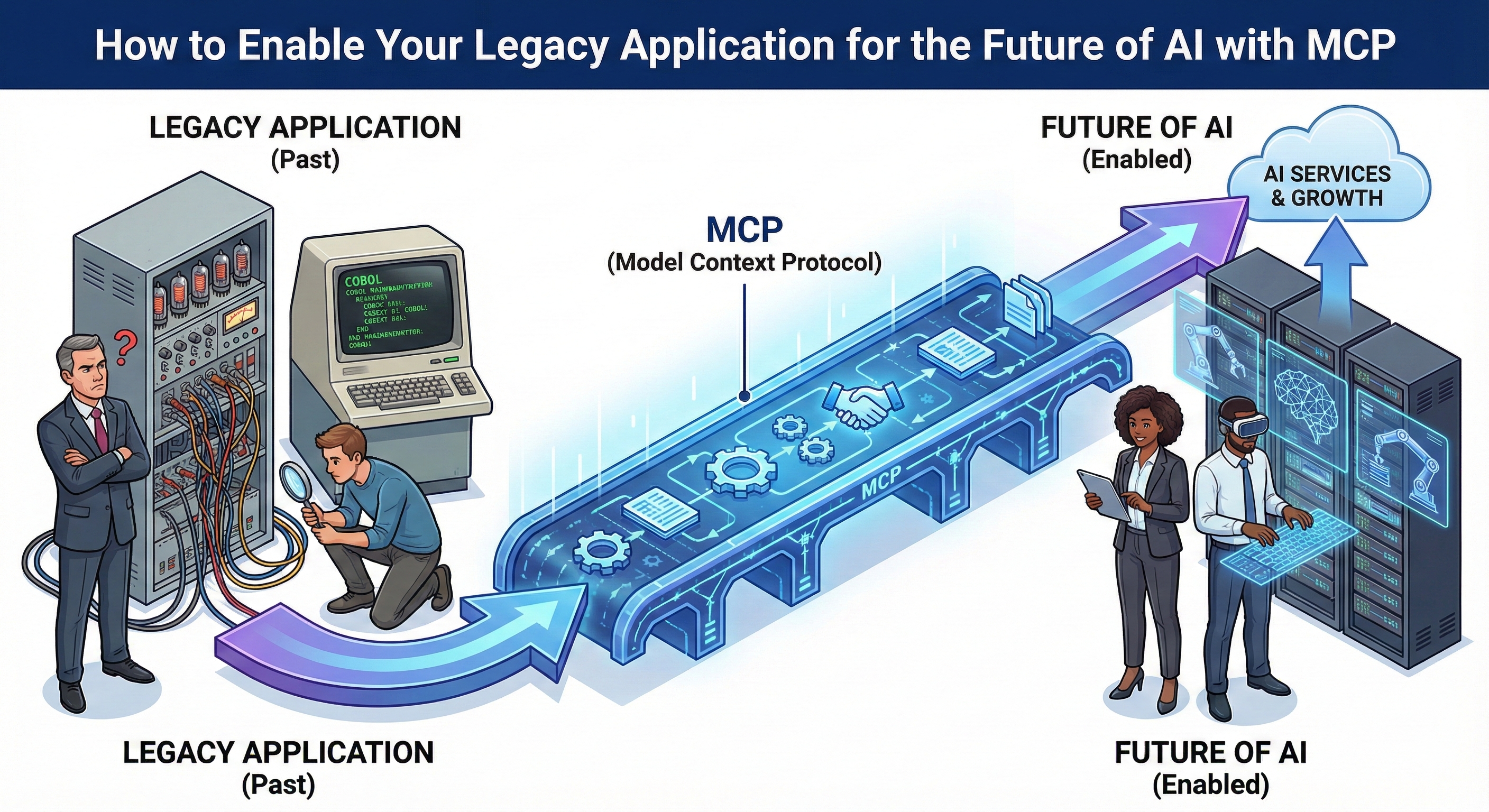How to Enable Your Legacy Application for the Future of AI with MCP
Discover how the Model Context Protocol (MCP) allows you to integrate legacy systems with artificial intelligence safely and incrementally, without rewriting your application from scratch.
Sapiens IT Team
Written by engineers who build before they write.

How to Enable Your Legacy Application for the Future of AI with MCP
Most companies dream of adopting artificial intelligence, but are still stuck with legacy systems that barely expose APIs.
The benefits are enormous — from automation to data-driven decisions — but the cost of rewriting everything is high.
Ignoring AI, on the other hand, can be the beginning of the end for any business that depends on software.
The good news is that there is a middle ground.
With the Model Context Protocol (MCP), you can enable your legacy system to interact with AI models safely and incrementally, without rebuilding your application from scratch.
Why don’t legacy systems and AI understand each other?
In most IT teams, working with legacy systems is synonymous with headaches.
An old system usually means two things:
- The software has reached maturity and is already too critical to be changed.
- The technology or business domain are no longer well documented.
With the arrival of AI, this reality has become a strategic problem.
Companies want their models to understand the business, but face obstacles such as:
- Absence of APIs or updated documentation
- Poorly structured data
- Business rules distributed in old code
- Lack of context for AI to understand user intentions
The result is predictable: AI doesn’t understand your legacy, and your legacy doesn’t know how to talk to AI.
What is MCP and why does it matter
The Model Context Protocol (MCP), proposed by Anthropic, is an open standard for communication between systems and AI models.
In simple terms: it defines a protocol so that an AI can query, understand, and execute actions within software, in a standardized and secure manner.
If HTTP was the protocol that allowed systems to communicate via the web, MCP is the protocol that allows AIs to communicate with corporate systems.
With it, you can:
- Expose data and operations from your legacy system as AI “tools”.
- Allow models to understand your application’s context without needing to rewrite anything.
- Gradually modernize your ecosystem, maintaining the existing foundation.
In other words: you transform your legacy system into an “AI-ready” system.
Applying MCP in practice
MCP implementation is simple and has little structural impact.
Languages like Java, JavaScript, .NET, and Python already have compatible libraries.
You can configure the protocol as a sidecar project or have the application itself act as an MCP server.
In this scenario, the client is the AI itself — which connects to your server to obtain context.
Let’s see an example in Java using Spring Boot and Spring AI MCP.
Step 1 — Adding dependencies
<properties>
<spring-ai.version>1.0.0-M6</spring-ai.version>
</properties>
<dependencyManagement>
<dependencies>
<dependency>
<groupId>org.springframework.ai</groupId>
<artifactId>spring-ai-bom</artifactId>
<version>${spring-ai.version}</version>
<type>pom</type>
<scope>import</scope>
</dependency>
</dependencies>
</dependencyManagement>
<dependency>
<groupId>org.springframework.ai</groupId>
<artifactId>spring-ai-mcp-server-spring-boot-starter</artifactId>
</dependency>Step 2 — Configuring the MCP server
spring.application.name=mcp
spring.ai.mcp.server.name=spring-mcp
spring.ai.mcp.server.version=1.0.0The server.name and server.version values serve to identify your server and control versions of available contexts.
Step 3 — Exposing tools for AI
In MCP, each tool is equivalent to a REST endpoint — a functionality that AI can query or execute.
Example: let’s expose a tool that returns all users registered on a specific date.
package com.example.mcp;
import org.springframework.ai.tool.annotation.Tool;
import org.springframework.ai.tool.annotation.ToolParam;
import com.example.repository.UserRepository;
import com.example.dto.UserDTO;
import java.time.LocalDate;
import java.util.List;
public class DatabaseLLMProvider {
private final UserRepository repository;
public DatabaseLLMProvider(UserRepository repository) {
this.repository = repository;
}
@Tool(description = "Fetch all users registered at a specific date")
public List<UserDTO> getAllUsersRegisteredAtDate(
@ToolParam(description = "Date used in the search") LocalDate date
) {
return repository.findAllByDate(date)
.stream()
.map(UserDTO::new)
.toList();
}
}The @Tool and @ToolParam annotations are the key point: they inform the AI about the purpose and parameters of the tool.
Avoid vague or generic descriptions — the context needs to be clear and direct so the model knows when and how to use the resource.
Step 4 — Registering the MCP server
For a client (such as ChatGPT, Copilot, or Cursor) to recognize your MCP server, a configuration file similar to this is required:
{
"mcpServers": {
"mymcp": {
"command": "",
"args": [
"--directory",
"/ABSOLUTE/PATH/TO/PARENT/FOLDER/myapp",
"run",
"artifact.jar"
]
}
}
}After registration, the AI will be able to connect and use the tools exposed by your legacy system as if they were native extensions.
⚠️ Precautions when exposing MCP tools
MCP is powerful, but must be used responsibly.
Some essential best practices:
- Do not expose databases or credentials directly.
- Validate parameters received from AI.
- Monitor logs and calls.
- Avoid generic tools — prefer specific contexts with limited scope.
This avoids prompt injection risks and keeps your infrastructure protected.
Conclusion
Implementing AI in a legacy system is possible — and MCP is an excellent first step.
It brings your technical team closer to the AI ecosystem without needing to reformulate the entire system foundation.
AI is not about replacing — it’s about expanding. If your system still doesn’t talk to intelligence, it’s time to change that. Contact us and discover how MCP can accelerate your transformation.
Written by the Sapiens IT team — engineers who build before they write.